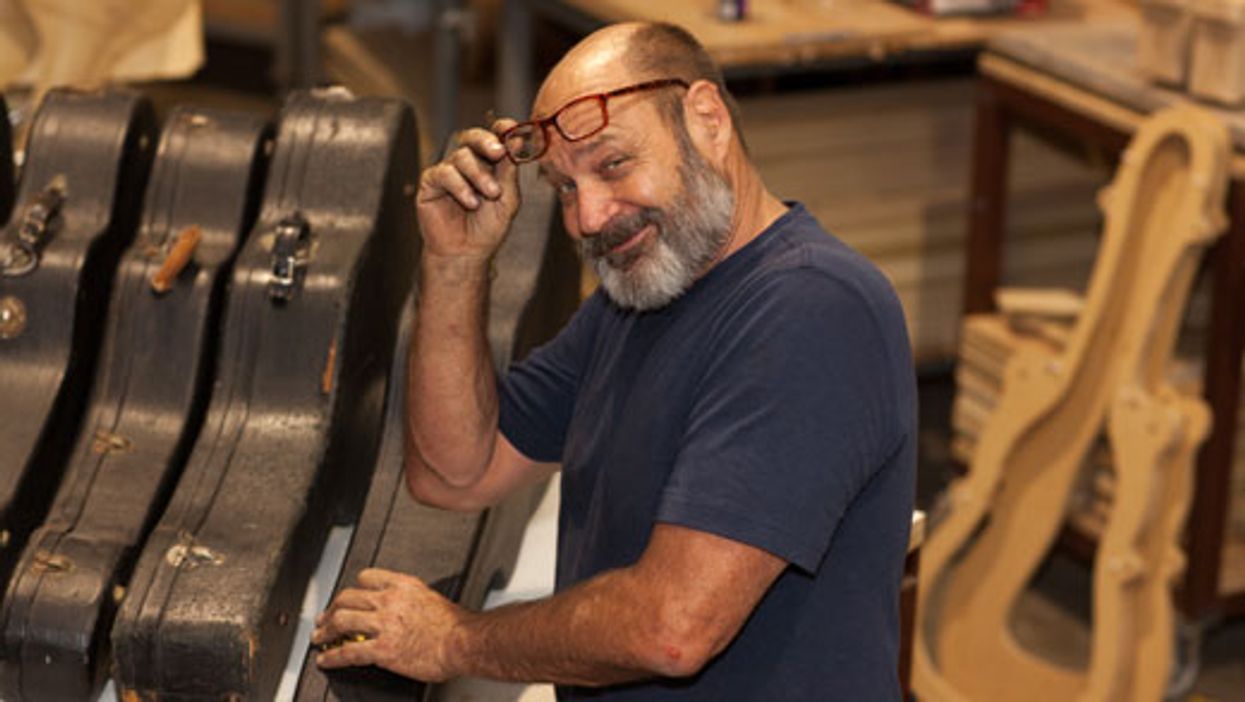Bill Collings, a giant of modern lutherie, died on Friday, July 14, due to cancer, leaving behind a legacy that touched generations of guitar builders and players. In the early 1970s, Collings dropped out of medical school and moved to Houston, where he worked as an engineer for an oil-field pipeline company by day and pursued his passion for building acoustic guitars by night. His devotion to form and function dictated the elegant construction of his instruments, which are known for their warm, crystalline tone and projection, and valued by scores of high-profile performers, including Lyle Lovett (who ordered his first Collings in 1978), Keith Richards, Joni Mitchell, and Pete Townshend. The average price for a new Collings dreadnought is $5,000, and he refused to make bargain-version guitars that might compromise the high quality associated with his name. Collings' first workshop was his kitchen table, but by 2012 his Austin, Texas, shop had grown to include 85 employees, who also make archtop guitars, electric guitars, and mandolins. Collings was a much-loved and respected figure in the industry. Steve Grimes of Grimes Guitars, Collings' friend and an expert builder of archtop and double soundhole instruments, has authored the tribute that follows:
July 15, 2017 started as another typically beautiful day on Maui. Then the weather changed dramatically. A friend called with the sad news that our friend Bill Collings had lost his brief but fierce battle with his terminal illness, and suddenly a dark cloud formed over the mountain. It extended far beyond the confines of this island state and out across the entire guitar world.
everything he knew with others.
I called a few friends that were also good pals of Bill's, and we commiserated over the sudden loss of a dear friend and colleague. But the sadness was repeatedly interrupted by laughter we couldn't hold back when we traded our best Bill Collings memories. We agreed no one could make us laugh the way Bill could, and the idea that his wry humor and trenchant wit were now taken from us hurt just as much as the thought of losing his mastery of lutherie and his brilliant, technical mind. Mixed emotions for sure—pain and laughter, side by side.
I met Bill in one of his first shops in Houston in the early '80s, when he was a one-man operation. I knew right out of the gate that I wanted to know him more, to find out how he ticked, and to learn what he knew. Even though we lived 4,000 miles apart, we managed to hang out fairly often at trade shows and lutherie conventions. One of my fondest memories was the way Bill would find my booth on the first day of the NAMM trade show in Anaheim, California, saunter up, say “aloha," and chat a while. All the time his caliper fingers were inside the soundholes of my archtops, checking top thickness and graduation. “Get your dirty fingers out of my f-holes!" I'd say, eliciting a jackhammer laugh from him. He'd strum a stiff stroke across the strings, listen for things that archtoppers listen for—attack, sustain, decay, overtones—and then ask, “a-hundred-and-sixty-thousandths?" “Four millimeters," I'd reply, amazed that his thumb and index finger could be that accurate!
Bill would occasionally call me at my Hawaii shop and pick my brain about archtops. Meanwhile, I was gathering golden tidbits of info from him on his building philosophies. We'd talk about finishes, archtop neck joints, and guitar tone. But each time the conversation would quickly expand and we'd talk and laugh about life, loves, wine, relationships, great food, and fast cars.
In this luthier's humble opinion, Bill's legacy lies not only in the fact that he was such an intuitive, perceptive engineer of great guitars, mandolins, and ukuleles, but in his dedication and passion for sharing everything he knew with others. I was one of the many lucky builders on the receiving end of his wealth of knowledge about guitar building. And his delivery … that was the icing on this cake of genius! This guy could sprinkle light and levity into dry technical facts better than anyone I'd ever met.
Above this layer of clouds, it's a beautiful day. This overcast will probably stick around for a while. I'll miss him dearly, but the sun will break through as soon as I conjure up another Bill Collings story.










![Rig Rundown: Russian Circles’ Mike Sullivan [2025]](https://www.premierguitar.com/media-library/youtube.jpg?id=62303631&width=1245&height=700&quality=70&coordinates=0%2C0%2C0%2C0)













![Rig Rundown: AFI [2025]](https://www.premierguitar.com/media-library/youtube.jpg?id=62064741&width=1245&height=700&quality=70&coordinates=0%2C0%2C0%2C0)




















 Zach loves his Sovtek Mig 60 head, which he plays through a cab he built himself at a pipe-organ shop in Denver. Every glue joint is lined with thin leather for maximum air tightness, and it’s stocked with Celestion G12M Greenback speakers.
Zach loves his Sovtek Mig 60 head, which he plays through a cab he built himself at a pipe-organ shop in Denver. Every glue joint is lined with thin leather for maximum air tightness, and it’s stocked with Celestion G12M Greenback speakers.











